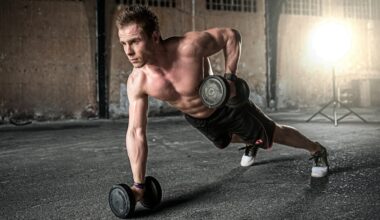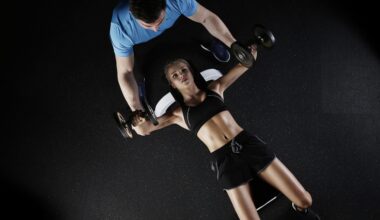Maximizing Gains with Bilateral Compound Lifts
Bilateral compound lifts are arguably the cornerstone of strength training, incorporating multiple muscle groups simultaneously. These exercises employ both limbs to perform movements such as squats, bench presses, and deadlifts. The major benefit of bilateral training lies in its ability to maximize strength and hypertrophy efficiently. By engaging more muscle fibers concurrently, you can enhance your overall performance both in the gym and in daily activities. Additionally, this approach fosters increased hormonal responses, promoting muscle growth and fat loss. Specifically, hormones such as testosterone and growth hormone play essential roles in recovery and body composition. When you focus on bilateral lifting, you ensure that you are working on these elements effectively. Balancing workload across the body, you can minimize injury risks and encourage symmetrical strength development. Furthermore, these lifts typically allow for heavier weights compared to unilateralism, contributing to increased strength adaptation. Therefore, integrating bilateral compound lifts into your routine offers a potent method to maximize gains and build a muscular physique. In conjunction with proper recovery strategies, nutrition, and consistency, you can amplify the benefits of these exercises.
Incorporating bilateral lifts into your training routine requires some thoughtful planning and execution. It is crucial to have a well-structured program that includes a variety of movements targeting different muscle groups effectively and safely. Elements to consider include your overall fitness goals, experience level, and the frequency of workouts. For beginners, starting with fundamental bilateral exercises can build a solid foundation. For example, performing squats and bench presses can help novices grasp the essential techniques before advancing to more complex variations. Intermediate to advanced lifters can further enhance their routines with variations, such as pause squats or tempo bench presses. These added challenges stimulate muscle fibers differently, promoting continued progress. When performing bilateral lifts, prioritize form over heavier weights to avoid injuries. Engaging core muscles for stability is key during lifts, ensuring proper alignment and balance. You might consider using a mirror for feedback or working with a trainer to assess technique. Additionally, listening to your body helps gauge fatigue and ensure adequate recovery. In turn, this will foster a more productive training session next time.
Benefits of Unilateral vs Bilateral Exercises
While bilateral exercises provide numerous advantages, considering unilateral exercises is also essential. Unilateral training focuses on one limb at a time, potentially improving muscle imbalances and stability. For instance, when you notice one side is weaker, incorporating single-arm rows or split squats can address weaknesses and enhance muscular symmetry. However, unilateral lifts often require more time per workout, necessitating careful scheduling to fit into a training plan. Moreover, integrating both types can produce complementary effects; bilateral exercises are great for developing overall strength, while unilateral exercises help with muscle activation and stability improvements. This synergy can lead to greater athletic performance. Additionally, both methods can impact your functional strength, which translates to daily activities or sports. Consider using a combination of both types of exercises within workouts or alternating focuses weekly. This holistic approach will not only provide variety in training but also foster comprehensive development of strength, coordination, and agility. Ultimately, creating balance through incorporating both unilateral and bilateral exercises fosters better overall performance and athletic longevity.
Fueling your body adequately to support strength training is key to achieving maximum gains. Nutritional principles apply equally to both unilateral and bilateral training. A well-rounded diet should focus on protein, carbohydrates, and healthy fats. Protein is particularly crucial for muscle recovery and growth, with recommendations generally around 1.6 to 2.2 grams per kilogram of body weight. Aim to include lean meats, dairy, legumes, and plant-based sources in your meals. Carbohydrates are vital, too, as they help replenish glycogen stores depleted during workouts. Consuming quality sources, like whole grains, fruits, and vegetables, can keep energy levels stable. Fats should not be overlooked either, as they are essential for hormone production and overall health. Remember that post-workout nutrition is key for recovery, so consider protein-rich snacks within an hour after training. Hydration plays an equally important role; prioritize water intake during and following exercise to stay hydrated. This fuels continued performance and decreases recovery time. Consistency in nutrition, coupled with proper training, creates the foundation for strength gains and achieves your fitness goals.
Proper Recovery Techniques
Maximizing gains from bilateral compound lifts inherently depends on effective recovery strategies. Recovery plays a significant role in strength training, allowing muscles to repair and grow after workouts. Delayed onset muscle soreness (DOMS) is common after intense exercise and emphasizes the need for rest. Adequate sleep, generally around seven to eight hours per night, allows physiological processes to occur, including muscle repair and hormonal balance. Additionally, consider incorporating active recovery methods, such as light walking or yoga, which can facilitate blood flow to sore muscles while reducing stiffness. Stretching and foam rolling can also enhance recovery benefits. This helps to alleviate tightness and improve mobility, enabling better performance during subsequent workouts. Moreover, you might want to explore alternative recovery modalities, such as ice baths or compression garments, which may aid in reducing inflammation and soreness. Ultimately, listen to your body and adjust your training intensity and frequency accordingly to optimize recovery. Balancing hard workouts with restorative practices makes for a well-rounded approach to training and develops consistent long-term strength gains.
In the pursuit of maximal gains, integrating technology can play a supportive role in training. Wearable devices and applications track progress, analyze performance, and monitor recovery. These tools can provide valuable insights regarding workout intensity, duration, and overall efficiency, allowing for informed adjustments in your training approach. For example, tracking how much weight is lifted during bilateral versus unilateral exercises can help you identify strengths and areas for improvement. This data fuels accountability and motivation as you witness tangible progress over time. Moreover, workout logs or journals can help document changes and reflect on successes or challenges faced in training. Setting short- and long-term benchmarks gives direction and clarity to your goals. Additionally, social media platforms or fitness communities can provide support and inspiration from others, reinforcing training commitment. Engaging with like-minded individuals can fuel motivation, encouraging a shared journey through fitness. However, keep in mind that each individual’s progress will differ. Keep your focus on consistency, patience, and dedication to personal goals, and let technology augment your journey towards maximizing results in strength training.
Conclusion
In conclusion, maximizing gains through bilateral compound lifts can offer incredible strength and size enhancement benefits when executed effectively. Recognizing the significance of incorporating both bilateral and unilateral exercises adds depth to your training program and allows for comprehensive muscle development. Focusing on recovery and nutrition as essential elements helps sustain growth while minimizing injury risks. Remember that consistency and patience are key themes in any fitness journey. Staying engaged, assessing progress through tracking technology, and refining your routine will ultimately lead to success. Balancing key workouts with proper recovery, fueling your body adequately, and adapting to individual needs will empower you to reach your fitness goals. Commit to a well-structured program that emphasizes compound movements while remaining aware of weaknesses to address through unilateral training. Knowledge, paired with dedication, can provide a fruitful pathway to achieving desired results. Embrace the journey of lifting, knowing that progress is a marathon, not a sprint. Success in strength training is attainable with dedication, effort, and a balanced approach tailored to your unique capabilities and aspirations.
As you embark on your strength training journey seeking to maximize your gains effectively, becoming educated about your methods can truly empower you. Equip yourself with the right information about bilateral compound lifts and incorporate them into your weekly routines. Not only will it help build functional strength, but it will also assist you in laying down a robust foundation too. Seek coaches or interesting literature which can expand your understanding and keep you inspired as you progress. Community support and online platforms can expand your knowledge and help you meet your goals. By nurturing a routine that includes education, consistency, and adjusting based on your body’s signals, you’ll ensure a balanced path in fitness.


